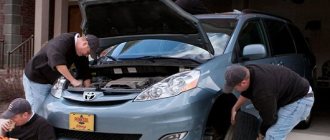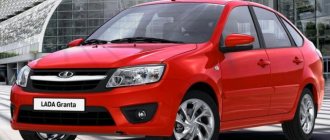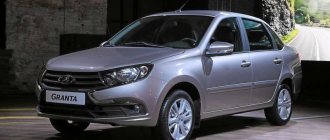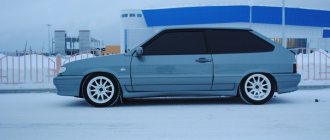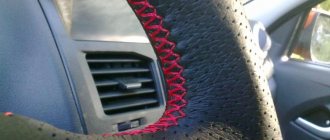Modern Lada car
Avid fans of the products of the domestic automobile industry and newcomers who are planning to purchase a car from the Lada series, among others, ask themselves the following question: is the body of the Lada Grant galvanized?
Scouring Internet resources, reading discussions on various forums and studying the documentation for this car, future mechanics cannot resolve their doubts. And all because some sources confirm, while others refute, information about galvanizing the body. Why is it so important to get reliable data?
The car body requires attention and expense from the car owner. The existence of a huge number of factors negatively affecting the body forces the car manufacturer to come up with ways to protect it. Such factors include adverse weather conditions (rain, snow), chemicals used to treat the road in winter, and much more. Of course, a layer of paint protects for the time being, until minor scratches and chips appear. But even a brand new car has unpainted areas of body parts that will begin to deteriorate first. This is why the question arises about treating all car surfaces with an anti-corrosion coating. But before you answer it, you need to understand what galvanization is.
Review of the new body
The fashion for all-terrain station wagons, as expected, has reached the Russian market, so experts called the appearance of Grants with increased ground clearance only a matter of time.
The first sales of the 2022 model year Lada Granta Cross will begin at dealerships on June 12. How is the domestic auto industry ready to surprise us this time?
The designers of the Grant Cross 2022 managed to raise the new car body above the road with the help of a modernized suspension, while maintaining the usual layout: a semi-independent beam at the rear and McPherson struts on the front axle.
The size range of tires has also partially changed: the cross version will be equipped with 195/55 R15 tires. The range of power plants for this model will traditionally remain modest: a 1.6-liter eight-valve 87-horsepower gasoline engine and a sixteen-valve engine with increased power (106 hp)
Both options are available with manual and automatic transmissions: either a 5-speed manual transmission or a five-speed AMT robot.
A pleasant surprise for owners of an automatic transmission will be the presence of the long-awaited creeping mode, in which the Lada Granta Cross 2019 will start moving when the brake pedal is released.
There is also an additional – sport mode of the gearbox, which provides faster switching from one gear to another.
Exterior
It's no secret that all new station wagon modifications of the Grant family are former Kalinas with a Vesta-style front end design. Accordingly, the Lada Granta Cross 2022 inherited a new radiator grille, a new bumper, optics and chrome inserts characteristic of the X-style.
The fact that we are not just dealing with a station wagon will be evidenced only by wider moldings on the sides of the body, a black trim on the trunk lid and a generally more developed protective body kit, which will not be painted in the color of the new body.
By the way, the color range includes 9 types of colors, including the popular orange Aurum.
Interior
The interior design of the Lada Granta Cross 2022 model year is completely borrowed from Kalina, as was done for all restyled Granta sedans and liftbacks.
Small changes can be found only in the area of the central air ducts with two stylish decorative inserts, and the instrument panel, the rims of which are framed in orange.
The designers of the Lada Granta Cross 2022 also replaced the padding material of all seats, making them less susceptible to fatigue deformation, and significantly increased the size of the armrests.
The general style of the interior design is determined by the usual contrasting inserts on the upholstery and steering wheel, and an ERA-GLONASS activation button has appeared on the interior ceiling.
The luggage compartment of the Lada Granta Cross is characterized by sufficient capacity given the overall compact dimensions of the car: 355 and 670 liters with the backrests of the rear sofa not folded and folded, respectively.
Technical stuffing
AvtoVAZ traditionally focuses on the budget and practicality of its equipment, so buyers will not be able to find the latest achievements in automotive electronics or acoustics in the cross-version.
At the same time, the 2022 Lada Granta Cross is a car that fully complies with modern safety standards established by Russian and European laws.
This predetermined not only the appearance of the ERA-GLONASS emergency warning system in the station wagon, but also frontal airbags for the driver and front passenger.
Among other standard options of the Lada Granta Cross 2022 are:
- heated windshield, which will appeal to car owners who operate equipment in conditions of high negative temperatures;
- audio system with hands-free function;
- driver's seat adjustment within a range of 40 mm;
- rear parking sensors;
- HSA system for easier starting on steep hills;
- stability control system
Is the body of LADA cars galvanized or not?
Galvanizing is the coating of metal with a layer of zinc to protect it from corrosion. In other words, the better the body is galvanized, the more resistant it is to rust. Is there a need to additionally carry out anti-corrosion treatment of the body or is this no longer relevant for modern LADA cars?
Car manufacturers use different galvanizing methods. High-quality galvanization of the body significantly affects the cost of the car; less reliable methods of protection cost factories much less.
The most reliable method is hot galvanizing , when the metal is coated with a layer of zinc by dipping the body into a bath of molten zinc at a temperature of about 460 °C. This method is used only by large manufacturers of European foreign cars.
To protect the body from corrosion, AVTOVAZ practices cataphoresis priming of the body . The “black” body is dipped into a bath with a special primer. A phosphate film is formed on the entire surface of the metal, which is the basis of the protective anti-corrosion layer of the car; the durability of the body depends on its quality.
Whose body is more resistant to corrosion: Kalina or Priora?
It is possible that at one time you were the owner of both a Kalina and a Priora, and in this case, of course, you know which car is more resistant to the appearance of rust and rot on body parts. If you think that both cars are domestic, and therefore will rust the same, then you are seriously mistaken.
I, as a former owner of Kalina, can tell you a lot about this car and am familiar with Priors firsthand, so I can certainly compare these cars of the same model year, especially since I have seen dozens of 100% disassembled cars and believe me, I have something say about this.
A look at the problem from the inside
Of course, there are no eternal cars, especially when it comes to the domestic automobile industry. But while some cars can last up to 10 years without significant signs of corrosion, others already in the third year are covered with red spots almost in a circle.
All the “delights” of Priora
For those in the know, you probably understand that in the first case we were talking specifically about Kalina, since the body of this car, if we consider all models before Vesta, is the most durable and resistant to corrosion. Don't believe me? Take the first Priora you come across, about 5 years old, and inspect it from the bottom. You will see with a 95% probability the appearance of rust along the seams of the doors below, a yellowed trunk lid and rust spots on the hood, which can eat the metal from the inside during this time, and this has happened more than once to many owners of these cars.
The trunk lid is a separate matter - one gets the feeling that on this part they simply saved several times on metal and almost all this is done from waste. Even a sedan, even a hatchback with a station wagon, the result is the same - a rotten trunk in 3-5 years, or even earlier. Here is a real example of the cover of a 5-year-old Lada Priora station wagon.
The rust spots that were cleaned off only worsened the situation, since the metal now became like a sieve - it really shines through. But what turned out to be even more interesting in this story is that this lid was ordered from the Caucasus with shipping from TK for as much as 3,000 rubles. That is, we can conclude that even in this condition, this part is normal for Priora owners.
Is Kalina that good?
But Kalina can no longer boast of such problems, since the assembly of this machine, according to many knowledgeable people, occurs completely differently, and the metal most likely is used is different. How else can we explain the fact that even 10-year-old Kalinas often have a more dignified body appearance than 3-year-old Prioras.
Again, this is not a special case, but a pattern that you yourself can trace if you go to inspect at least 10 cars of the same and second models with the same years of manufacture. Moreover, it is worth saying that the first generations of both one model and the other were of higher quality in terms of metal. Now you can find a door with holes in it even on the new Kalina-2, although these cases are quite rare. But this kind of marriage is not excluded and a large number of car enthusiasts are aware of this.
Speaking about my personal car, which I have used for more than 7 years, I can say the following. Not a single body part has even a speck of rust. Moreover, the car is outdoors all year round, washed no more than once a month, and it definitely hasn’t seen any special care. So, as far as anti-corrosion properties are concerned, Kalina in this regard outshines Priore in no time.
- A sports modification of the Hyundai i30 Fastback has been presented
- 5 mistakes when adjusting rear view mirrors
Spy photo reveals new generation Range Rover
Features of the Lada Granta body
The new Granta body, of course, is superior in quality and characteristics to other models and cannot but please the owners. More modern technologies, galvanization and high-quality coating are big words that please the ear of a lover of products from the domestic automobile industry. But it should be taken into account that not the entire body undergoes anti-corrosion treatment, but only the areas most susceptible to destruction. Moreover, the manufacturer warns that the warranty for body protection against rust is 6 years, and then the car may need additional treatment. But a lot also depends on the operating conditions of the Lada Granta car. Compliance with all rules for the use of transport and appropriate care can increase the service life of factory galvanized steel up to 10 years.
Lada body structure
What parts of the Lada body are galvanized? First of all, these are niches for the rear and front wheels, as well as the bottom (on both sides), sills, luggage compartment lid, doors, pillars and hood.
Often in car dealerships you can find examples of Lada Granta cars, which are completely similar to other series and equipment, but much cheaper. The tricky move of many dealers is to convince the buyer that this car is simply participating in the promotion and is no different from its relatives. In fact, some batches arrive from the factory without galvanizing the body - this is an economical option.
Now you can easily answer the question: is the body of the Lada Granta car galvanized?
The VAZ automobile plant produces Lada Granta cars, the body of which may or may not be galvanized. The galvanizing method chosen is not the most reliable; the effect will last only 6 years. In addition, it must be taken into account that only individual parts of the body are galvanized.
Comparative characteristics
From the above we can draw the following conclusion:
- Granta is cheaper than Kalina;
- Grant has a modern platform, better handling;
- to the detriment of safety and quality, Grant simplified the headlight unit and other body parts, but this lowered the price of the car;
- Grant has a higher quality paintwork. Less susceptible to corrosion, retains natural color longer.
- Compared to Kalina, Grant has better sound insulation, which allows you to talk in the car even at high speed.
It would be worth considering some parameters in more detail and comparing them.
- Appearance of cars. Upon a superficial examination of the new product, it may seem that the Granta is not like other Russian cars. Upon closer inspection, it is noticeable that the side doors are the same as those of the Lada Kalina. And the sedan bodies of both models are generally not much different. The Granta can only be recognized by its large size and a different shape of the bumper and headlights.
- Luggage compartment. When it comes to trunk space, the Lada Kalina remains on the bench. Due to the fact that Granta's body is longer than that of Kalina, its trunk is much larger. It’s just that the appearance of the trunk is “lame”, and it doesn’t close the first time. But the size of the trunk is louder than its shortcomings, and this is good news.
- Salon overview. Kalina users often received complaints about the unbearable creaking of the panels, a large number of gaps and backlashes. In the new Lada Granta, these shortcomings have been corrected, and the interior makes almost no unnecessary unpleasant sounds. But regarding the plastic in the car, there is a question: is it cheap? Despite this, the interior of the Lada Granta also has its advantages:
- beautiful and pleasant instrument panel;
- cup holders installed;
- the glove compartment has been enlarged;
- There were no problems with the heater operation.
- Steering rack. A significant advantage of the Grant over the Kalina is the shortened steering rack. This solution made it easier to drive the new car. But there was no room in the vehicle for an ashtray, but all was not lost.
- Power unit. The engines in both cars are almost the same, but the Granta has some advantages. With the same number of valves per cylinder, the Kalina engine is capable of developing a power of 82 horsepower, and
Grant - 90. Such indicators can be explained by the fact that the latter has a lightweight connecting rod and piston group. The Granta's power unit works faster, unlike the Kalina, and there is no unnecessary noise.
- Safety system. It is worth noting that the Grant has two airbags, which cannot be said about the Kalina, and this is a good indicator, considering the new product as a budget car.
In addition, the new product, like its competitor Lada Kalina, will exist in a hatchback body. Granta in a hatchback body looks more youthful, but Lada Kalina is more functional in terms of transporting large loads.
Body
For the liftback, as for the sedan, the Lada Kalina platform is taken as the basis. Externally, the car looks impressive and even a little better than its counterpart in a different body. The new rear end blends very well with the face of the car. The entire body is made in a style that is vaguely reminiscent of some Renault models (for example, Sandero or Logan), but at the same time has Korean features. Despite this, the car looks more than decent, especially for its class. Basically, this was achieved thanks to the unusual shape of the car body, which everyone is accustomed to seeing in the form of a sedan. The upper edge of the rear roof has been lowered by 8 mm.
Painting Lada Vesta
It begins immediately after the completion of the cataphoretic priming process. First, the preparatory equipment is dismantled from the car, which is placed in a special container behind the car, and the paint shop is installed. This equipment allows you to open and close the doors, hood and trunk. By the way, the entire line is equipped with special emergency buttons, pressing which completely stops the conveyor.
The painting stage begins with the application of joint mastic to all joints, which increases corrosion resistance. In addition, line workers also spray anti-noise mastic, which reduces the noise level in the cabin.
After this comes the turn of applying primer. In this case, the bulk of the operation is performed by robots, but workers also have to prime the metal in places where the robots cannot reach. For the most part, these are the inner sides of the pillars, the edges of the roof, covered by doors, etc.
d. The color range of the primer is limited to only two tones - light and dark. His choice depends on the future color of the Lada Vesta.
First, a primer is applied to the body. After priming is completed, the machines are sent via conveyor to the secondary soil processing area. In this department, employees eliminate painting defects using special paste and brushes.
Only after completing all these stages, which take about 3 hours, the finished body is sent to the painting booths, where robots work side by side with people. First, the metal is covered with a layer of paint, after which comes the turn of varnishing. At the end, the painted sedan body enters a thermal chamber, where it is dried. This takes about 40 minutes.
At the end, the finished body is sent to polishing and the assembly line.
After drying, a few final touches remain - polishing and anti-corrosion treatment of cavities. In the latter case, plant workers, armed with special sprayers with long nozzles, fill the internal surfaces of the cavities (thresholds, pillars, etc.) with an anti-corrosion compound.
Galvanizing the body of VAZ Granta 1st generation
Other generations of VAZ Granta
When a galvanized surface is damaged, corrosion destroys zinc and not steel.
| • | Complete - the car body is processed completely, including hidden and hard-to-reach cavities. | ||
| • | Partial - all joints and the most vulnerable parts of the body, sills, bottom, bottom of doors are processed. | • | Nodal connections - includes only processing of welding points, fastenings, stampings and other small parts. |
Over time, the processing process has changed. A younger car will always be better galvanized!
| • | Hot - Best type. High corrosion resistance, resistance to mechanical stress, partial regeneration property. | ||||
| • | Galvanic - Good type. Less corrosion resistance, ideally combined with paint and primer. | • | Zinc metal - Acceptable type. Metal with an elastic zinc-based coating, weak anti-corrosion properties, resistance to mechanical stress. | • | Cold - Bad type. Anaphoretic soil with an admixture of zinc is not able to resist corrosion. |
The presence of zinc particles in the soil covering the car body does not affect its protection and is used in advertising materials. More information.
Below are the test results of cars that came off the assembly line with the same damage (cross) on the lower part of the front right door. Tests were carried out in the laboratory. The conditions in the hot salt fog chamber for 40 days corresponded to 5 years of normal operation.
Hot dip galvanized vehicle
(layer thickness 12-15 microns)
Galvanized car
(layer thickness 5-10 microns)
Cold galvanized vehicle
(layer thickness 10 µm)
Car with zinc metal
• A coating with a thickness of 2 to 10 microns provides excellent protection against the occurrence and spread of corrosion damage.
• The rate of destruction of the active zinc layer at the site of body damage is from 1 to 6 microns per year. Zinc is more actively destroyed at elevated temperatures.
• If the word “full” is not added, this means that only impact-prone body elements were treated.
• Pay special attention to the presence of a manufacturer's warranty on the car body rather than loud advertising about galvanization.
Source
Generator: Valeo brand, made in Türkiye
The generator of the same French brand Valeo, but already made in Turkey, confused us at first - instead of the usual orange transformer varnish, the windings are covered with protection that is not uniform in color. However, as they say, “the speed should not be affected.” But we consider the fact that the terminals from the winding were not soldered, but simply crimped, to be a disadvantage. Not durable.
Three more Valeo components found: starter (Poland), release bearing and climate control unit (Czech Republic). The French company is one of the world's main manufacturers and suppliers of components for car factories, including, of course, fellow countrymen from Renault, from whom it migrated to AvtoVAZ.
In order for the Lada Vesta to stop properly, manufacturers from almost half of Europe had to work hard. In total, we counted five countries producing the braking system, including French SNR bearings pressed into the rear brake drums (integrated with the hub) of the German ATE brand, but of Italian production.
The only question regarding the brakes arose when considering the front pads, on which there was a working mark of the cylinder - a quarter of the pressing surface extends beyond the pads. It is difficult to say whether this somehow affects the braking efficiency. While driving, we had no complaints about the braking system.
You will also have to tinker with the suspension elements during repairs. According to “foreign” patterns, the ball (produced by the BelMag Magnitogorsk plant) comes assembled with a lever. Moreover, replacing a component will require a lot of additional actions to free up space around it. By the way, according to servicemen, play of ball joints and knocking of stabilizer struts are the most frequent complaints from the first owners of Vesta.
Shock absorbers are one of the few Vesta components on which we did not see the “Aglitsky language”. The racks were produced at the Skopinsky Automotive Assembly Plant in the Ryazan region. By the way, in terms of the balance of suspension characteristics, we recognize Vesta as one of the best in the class.
We saw the only “Made in China” inscription on the windshield wiper motor from Bosch, with the logos of another automaker - the Chinese company Chery
How to determine if a body is galvanized
So, if simply assurances that the Lada Grant’s body, albeit not completely, is galvanized, is not enough for the buyer, everything can be checked. However, this is not so easy to do. To find out the exact answer to your question, you will have to fork out a lot for special research.
But first, you should still look at the documents for the car, where it will be stated in black and white that “the body is partially galvanized.” But there are also particularly distrustful citizens who want to see this for themselves. Such a person will need to find a laboratory that specializes in conducting such examinations and pay the workers for their labor and the reagents used.
The only way to personally identify the presence or absence of treatment is to find an unpainted area on the body and assess its condition. This is easiest to determine on used cars that are more than 5 years old.
There you can simply pay attention to any good scratch or paint chip. If there are no signs of corrosion in this place, no rust is visible, most likely the body or this part of it has been treated
Potential buyers and car owners are concerned with the question: does the Grant model have a galvanized body or not? The concern is easy to understand: the cost of the body is a significant part of the price of the budget car Lada Granta, galvanization protects the structure from the influence of adverse external factors.
Different sources provide conflicting information. Official representatives of the AvtoVAZ concern claim: the Lada Grant has a galvanized body, some sales dealers refute the statement.
How to care for an expensive car body, regardless of whether the body of the Lada Grant is galvanized or not?
What is body galvanization and why is it needed?
Car body
Galvanizing, or more correctly, galvanizing, is the application of a layer of zinc to the surface of the body using various methods in order to protect it from corrosion. Zinc is used because when it interacts with air, it oxidizes and forms a film that prevents oxygen from oxidizing the metal. This very film protects the car body from rust and corrosion.
The body is galvanized first to extend the “life” of the car. Automotive companies use different galvanizing methods. Due to the fact that each method requires different costs, prices for different brands of machines depend on the method and quality of processing.
The service life of a well-galvanized Lada Granta car increases by tens of years, and if during this time the car becomes a rarity, it can be sold three times more expensive. Or, at worst, pass it on to children and grandchildren by inheritance.
But is the body of the Lada Grant properly galvanized?
Fuse box and its housing: Renault brand, made in Romania
The fuse box comes entirely from the Logan model, as evidenced by the Renault logos on the body and the Romanian manufacturer Capirom. True, AvtoVAZ reported that in the near future the company will change its supplier to a local one - from the Samara region.
We didn’t have any questions regarding the unit itself, but during a scrupulous study by the electricians, a very interesting point emerged
Attention was drawn to two fuses that were not indicated either on the diagram or in the instructions. A study of the electrical circuit revealed that during a sudden voltage surge (for example, when lighting a Vesta with the engine running), these fuses may burn out, which will stop charging the battery
The controls also turned out to be imported - the steering rack is from the famous German brand ZF, but made in Malaysia. And the CV joints are provided by the British company GKN and made in Poland.
When painting, we get the following “pie”, the thickness of the body metal is 0.6-0.8 mm:
- Zinc, first layer;
- Cataphoretic primer;
- Polyester cataphoretic primer - second layer;
- Enamel;
- Varnish.
This technology prevents metal parts of the car from rusting. Therefore, AvtoVAZ has established a 6-year warranty on the Lada Vesta against through corrosion. The body of the Lada VestaLada Vesta with a galvanized body has only the outer side coated, the inner surface is simply covered with primer and painted.
This is due to the fact that the outer surface is subject to mechanical damage from sand and gravel from oncoming traffic and car wheels. As a result, chips and scratches appear on the body. The inner surface is not subject to any mechanical damage, so there is no need to galvanize additionally. Anti-noise protection is applied to the bottom of Vesta between layers of cataphoretic soil.
It performs galvanizing using zinc-filled paint, i.e. Fine zinc dust has been added to the paint. This is not the high-quality hot zinc coating of a car, which is used by foreign automakers, but the use of this technology gives good results.
Features of galvanization
Galvanization avoids rust in the most problematic areas
AvtoVAZ factories have recently increasingly begun to treat the body and other metal parts of cars with a layer of galvanization. Of course, not all metal elements of the Lada Grant are covered with a protective layer; this only applies to the areas most vulnerable to rust. Examples include the underbody of a car, doors, pillars. The body is only partially processed. Full galvanization can only be achieved if the owner carries out additional procedures aimed at protecting the car.
The galvanizing procedure is carried out directly in the press shop. According to the manufacturer, protection is applied to the Lada Granta according to the same principle that was repeatedly tested on the Lada Kalina. Thanks to the use of this technology, owners are able to avoid additional financial losses on anti-corrosion treatment. AvtoVAZ also guarantees that the Lada Granta will be reliably protected for more than 5 years after the vehicle starts operating.
When purchasing, you should also pay attention to the fact that most AvtoVAZ dealers claim that the low cost of the car is directly related to the lack of anti-corrosion coating. Therefore, when purchasing from a car dealership, check with the seller whether the body has been processed at the factory or whether you will have to do this procedure yourself. Parts subject to corrosion:
- body, if made of sheet metal that is not galvanized;
- rear doors, sealing rubber rubs the upper edge of the door;
- trunk lid if not installed correctly;
- the joint between the roof and the windshield if the glass installation was done poorly;
- hood edge, mechanical damage.
Now let's debunk some myths
1. Does the galvanized body confidently resist the onslaught of corrosion?
Even in a situation where the dealer gives a positive answer to your question about the presence of galvanized body on the Lada Grant, it is still too early to relax. The “Russian” coating has a small thickness, which entails a rapid loss of the protective zinc layer. Without the use of measures aimed at additional treatment of body components, the panels will still slowly corrode.
2. Does the new body need additional processing?
Practice has confirmed the imperfection of the factory protective layer. Despite the newness of the car, it requires immediate treatment in order to improve its anti-corrosion properties. The operation of a LADA Granta car implies exposure to various types of mechanical stress, which provoke the formation of cracks in the structure of the coating. The process is accompanied by the penetration of moisture, which leads to the appearance of corrosion centers.
3. Is the aluminum body free from rust?
In a real situation, there are no bodies made only of aluminum, whether the body is galvanized or not. In any structure there is the presence of steel components, which suffer the fate of being damaged by corrosion. Aluminum during operation of LADA Granta is subject to oxidation, which causes a weakening of its strength structure.
4. Is standard anti-corrosion protection capable of maintaining its condition for many years?
The rate of corrosion progress is directly influenced by the operating conditions and climatic factors, regardless of whether the body is galvanized or not. In just 6-7 years, a layer of metal with a thickness of 0.6 mm can corrode to through holes. This circumstance requires protective treatment of the body.
5. Are protective plastic panels (fender liners, mud flaps, etc.) really useless?
This is a false statement, because protection of this nature can reduce the dynamic impact of stones and dirt on body cavities. Installation of these accessories is carried out using self-tapping screws, and their joints with body components are treated with appropriate anti-corrosion coatings.
Features of anti-corrosion treatment
Regardless of whether the body is galvanized or not, certain rules must be followed. The optimal time for implementing anti-corrosion measures in LADA Granta is a dry and warm period. It is recommended to carry out the work annually or once every two years (as appropriate).
If the procedure involves treating external and unprotected body surfaces, then bitumen-based mastic is perfect. The process is not complicated, so it can be easily done at home. There are mastics both drying and lacking this quality. The latter options are characterized by sufficient elasticity, but are not resistant to mechanical factors. Application of mastic involves achieving a layer thickness of 0.4 mm, which allows for maximum noise insulation effect.
To effectively treat hard-to-reach and hidden cavities on the body, it is recommended to use substances based on an oil structure. This allows you to effectively fill pores and cracks. Elastic mastics are also excellent, one of the advantages of which is the ability to effectively displace moisture. These processing agents have a paraffin or wax structure.
About design
The design of domestic cars this time has exceeded any expectations: they look stylish and modern. You can safely put them on a par with foreign B-class cars (by the way, the Granta is closer to class C in size). But it seems that a little more imagination was put into Kalina 2, it looks a little fresh. A comparison of Lada Grant and Lada Kalina 2 is impossible without a clear understanding of the advantages and disadvantages of different body types. If you like efficiency and compactness, then a hatchback is suitable, if a large interior space is desired - a station wagon, and in both of these cases, your needs will be satisfied by the Lada Kalina 2. Do you need a classic and moderately representative look? It's better to stay with the Lada Granta.
There are no special comments regarding the corrosion resistance of the bodies. With age, the Lada Granta develops problems with locking the doors, especially the rear ones: you need to make an effort. Lada Kalina 2 does not have such a drawback.
Which Lada models have a galvanized body?
It is unknown what percentage of parts are galvanized. Various figures periodically appear in the media, but they are not officially confirmed. The degree of galvanization of Lada cars from the media (list):
- VAZ 2110 - 30%;
- Lada 4×4 (Niva 2121 and 2131) - cataphoretic priming, no galvanized steel.
- Lada Kalina 1 - 52%;
- Lada Kalina 2 - everything is galvanized except the front and rear side members, roof and hood;
- Lada Priora - since August 2008, the body has been galvanized by 29%, and after 2009 by 100% (video);
- Lada Largus - photos of galvanized parts were posted by tourists who visited AVTOVAZ as part of excursions;
- Lada Vesta - for the first time, the outer layer of the body was galvanized (the roof of the sedan is not galvanized, the station wagon is completely galvanized), and the sills and bottom have anti-gravel protection;
- XRAY - only the roof of the external panels is not galvanized, but this is normal practice for the global automotive industry. When testing the corrosion resistance of the body, the XRAY roof passed the test better than the Vesta roof.
- Lada Largus - all external steel panels are galvanized on both sides - outside and inside (indicated on the website lada.ru).
- Lada Granta sedan: 32% of the weight of body parts is made of galvanized steel. Moreover, 75% of galvanized metal is hot-dip galvanized steel with 2-sided coating. Strong and durable anti-gravel coating on the bottom. Hidden body cavities are treated with anticorrosive. The muffler is made of stainless steel (indicated on the website lada.ru).
- LADA Granta liftback uses galvanized steel (bottom, mudguards, sides), high-strength steel (power frame of the body). Polyester primer with increased resistance to chipping, black edging of the bumper skirt (indicated on the website lada.ru).
- Lada XRAY: double-sided galvanization of external body panels. Anticorrosive underbody and hidden cavities of the body (link).
- Lada Vesta: external body panels are galvanized, and a durable anti-gravel coating is applied to the sills and bottom (link).
- Lada Niva Travel - the main part of the body elements is made of metal with one-sided zinc coating, some with double-sided coating (link).
- Until 1999, AVTOVAZ did not have galvanized bodies; only a regular anti-corrosion layer was applied;
- from 1999 to 2009, cold galvanizing began to be used (application of a zinc-containing coating), but only part of the joints (welding points, fastenings, stampings and other small parts) were processed;
- Since 2009, cold galvanizing began to extend to a wider list of parts (all joints and the most vulnerable parts of the body, sills, bottom, bottom of doors, etc.
Budget galvanizing of Russian cars - does it make sense?
The bodies of Russian cars were very rarely coated with zinc. Now VAZ, UAZ and partly GAZ use such protection in the production of their cars. To reduce the cost of the final product, factories often galvanize their products partially, protecting the most vulnerable areas from corrosion.
One-sided zinc coating is often used:
- body elements;
- individual components and assemblies from the outside.
The inside of the metal is coated in the traditional way using primer and paint.
Today, there are only a few domestic manufacturers that galvanize their products, improving the quality of protection. Until 2014, partially cold galvanizing was used by UAZ and VAZ.
Now the situation has improved somewhat and some cars have appeared with a maximum galvanized area. Here, of course, we are talking about real protection, and not about an advertising ploy:
- Since 2014, UAZ Hunter, Pickup, Patriot, 23602-cargo has undergone full double-sided galvanizing, during which the body is immersed inside a special container. At the output, a protective layer with a thickness of 9-15 microns is obtained.
- Lada Priora is covered with zinc by 80-90%.
- The Vesta model is completely processed, except for the bottom and sills. This car became the first representative of the VAZ family with double-sided body treatment
- Lada Kalina of the first and second generation has almost the same galvanized area, which is about 50%. All hanging elements are galvanized here. Later models have a completely galvanized body, with the exception of the side members, roof and hood.
Against this background, other Russian models are galvanized, as they say, as a distraction and with practically zero benefit:
- The body of the Lada Granta sedan is only 30% made of galvanized steel. This only applies to doors and fenders. The metal is partially galvanized on both sides.
- The Largus model has galvanized front fenders, trunk lid, doors, and sills.
- The body of the Lada X-ray is subjected to double-sided processing, with the exception of the roof and bottom.
- Since 1999, the VAZ 2110 has been protected from corrosion by cold galvanizing. In this case, the main efforts were directed to welding seams and nodal connections. This coating provides virtually no protection against rust.
- GAZ cars (Gazel, Sobol, Siber) were processed according to the type of cold galvanizing of node connections.
When choosing a car, it is important to focus not so much on the advertising statements of manufacturers, but on their guarantee of body parts. Only under these conditions can you count on the durability of the machine.
Galvanizing methods
- Thermal (hot) galvanizing. The zinc alloy is applied to the sheet while it is being rolled on a conveyor, or the sheet is simply dipped into a container with the appropriate contents. This method is considered the most reliable and is used in the manufacture of many luxury foreign cars.
- Galvanizing by galvanization. This method is used in the manufacture of the Lada Granta car. Its essence is that the metal is processed by dipping the sheets into a bath of electrolyte containing zinc, which adheres to the surface of the material due to the action of electric current. This method is less reliable and is mainly used for galvanizing individual parts of the body.
- Cold galvanizing. A method widely used by manufacturers of many modern cars, but the most complex. First, the surface is treated with manganese, zinc and iron salts, then a primer is applied, and then paint with finely dispersed zinc in its composition. In other words, this method is not galvanizing in the literal sense. Rather, it is a high-quality body painting using anti-corrosion additives.
- A method that was popular in the early 70s of the last century and is still of the highest quality is the use of zinc metal. The technique involves treating metal sheets by applying a layer of zinc-based epoxy paint and a corrosion inhibitor. The advantage of the method is that even with mechanical damage, the metal will not lose its anti-corrosion properties. After such processing, the material can be given any shape and without fear of deteriorating its quality.
Since the Lada Granta undergoes a less effective method of galvanizing the body, the conclusions are obvious. And experts and automotive critics unanimously argue that the galvanic cold galvanizing method does not protect the metal from corrosion at all, but simply slightly delays the time when the first rust appears. Although in commercials the fact of galvanizing the body is almost in first place.
Four types of technologies
A little about why zinc (Zn) protects steel - it is a non-ferrous metal, has a more negative potential and corrodes first (that is, when it collapses, it protects the coating underneath), and the protection works even when it is damaged or partially destroyed.
To apply particles of protective metal to the body, there are only four main technologies, I will list them from best to worst.
Hot method. When the fully assembled body is dipped into a bath filled with zinc. Moreover, the temperature stays around 460 – 500 degrees Celsius. The method is very expensive and costly. Used by expensive brands on luxury cars - PORSHE, VOLVO, now on some premium HYUNDAI, etc.
- Galvanic method. The method consists in the process of deposition on the cathode (in our case, part of the body), positively charged particles (ions) of zinc from aqueous solutions (electrolytes). This technology works by passing a direct electric current through it. This is a less expensive and simpler technology, used by Mercedes, BMW, TOYOTA, Honda, Mitsubishi, KIA, etc.
- Zinc metal. It is used mainly by KIA, on cars from the “C” class. This is a kind of plastic coating that consists of two layers.
- Cold method. In essence, this is a kind of painting. A powder is applied to the body parts, which contains small particles of zinc powder. Used by many brands (Chevrolet, KIA, HYUNDAI, TOYOTA) including AVTOVAZ.
As you understand, VESTA is processed using the third technology; you choose where and in what volume to apply this layer.
This is where the disadvantages appear, namely the uniformity and thickness of the coating. It is also worth remembering that this layer is not 100% corrosion protection; it needs to be further strengthened.
We independently protect the body from corrosion
Factory galvanized car
To protect the underbody when interacting with various substances (water, chemicals), a special mastic is used, before using which the surface is thoroughly washed from dirt and all cracks are treated with anti-corrosive.
The drug "Movil" protects metal parts of the body from moisture. Special additives in the composition help push moisture out of the metal surface. "Movil" should be used with caution near rubber objects on the body, as it can destroy them.
A method for those who did not have time to protect their body, and the first signs of rust have already appeared on its surface. Now it is important to prevent the situation from worsening. It is appropriate to use products with orthophosphoric acid, which converts corrosion into a soil mixture. This product can be used even before painting the car body, without first removing rust and priming the surface.
Car body stiffness table
| car model | Hardness, Nm/deg |
| Alfa Romeo 147 3d | 18800 |
| Alfa Romeo 147 5d | 16250 |
| Alfa Romeo 156 | 18800 |
| Alfa Romeo 159 | 31400 |
| Alfa Romeo 166 | 24400 |
| Alfa Romeo MiTo | 17650 |
| Aston Martin DB9 Convertible | 15500 |
| Aston Martin DB9 Coupe | 27000 |
| Aston Martin Vanquish | 28500 |
| Audi A2 | 11900 |
| Audi A8 D2 | 25000 |
| Audi A8 D3 | 36000 |
| Audi A8 D4 | 45000 |
| Audi R8 | 40000 |
| Audi TT Coupe mk1 | 19000 |
| Audi TT Roadster mk1 | 10000 |
| Audi TT Roadster mk2 | 22000 |
| Bentley Azure | 18000 |
| Bentley Continental Supersports | 24000 |
| Bentley Flying Spur mk2 | 36500 |
| BMW 7 series E65 | 31200 |
| BMW 7 series F01 | 37500 |
| BMW E34 | 17200 |
| BMW E36 Touring | 10900 |
| BMW E39 | 24000 |
| BMW E46 Convertible | 10500 |
| BMW E46 Coupe | 12500 |
| BMW E46 Sedan | 13000 |
| BMW E46 Wagon | 14000 |
| BMW E60 | 24000 |
| BMW E90 | 22500 |
| BMW F10 | 37500 |
| BMW F30 | 25000 |
| BMW X5 E53 | 23100 |
| BMW X5 E70 | 28000 |
| BMW Z3 mk1 | 5600 |
| BMW Z4 Coupe mk1 | 32000 |
| BMW Z4 Roadster mk1 | 14500 |
| BMW Z8 | 40000 |
| Bugatti EB110 | 19000 |
| Bugatti Veyron | 50000 |
| Chevrolet Corvette C5 | 9100 |
| Chrysler Crossfire | 20140 |
| Citroen Picasso mk1 | 17000 |
| Daewoo Lanos 3d 1997 | 10500 |
| Daewoo Nubira 1997 | 14500 |
| Dodge Durango mk1 | 6800 |
| Dodge Viper Coupe mk2 | 7600 |
| Ferrari 360 Spider | 8500 |
| Ferrari 575M Maranello | 14700 |
| Ferrari F50 | 34600 |
| Fiat Brava | 9100 |
| Fiat Bravo | 10600 |
| Fiat Punto 3d | 19700 |
| Fiat Tempra | 6700 |
| Ford Fiesta 3d 1995 | 6500 |
| Ford Focus 3d mk1 | 19600 |
| Ford Focus 5d mk1 | 17900 |
| Ford GT | 27100 |
| Ford GT40 MkI | 17000 |
| Ford Maverick 5d 1995 | 4400 |
| Ford Mustang 2003 | 16000 |
| Ford Mustang 2005 | 21000 |
| Ford Mustang Convertible (2003) | 4800 |
| Ford Mustang Convertible (2005) | 9500 |
| Jaguar XK mk2 | 16000 |
| Jaguar X-Type Estate | 16300 |
| Jaguar X-Type Sedan | 22000 |
| Koenigsegg Agera | 58000 |
| Koenigsegg Agera R | 65000 |
| Koenigsegg CC-8 | 28100 |
| Lamborghini Aventador | 35000 |
| Lamborghini Gallardo | 23000 |
| Lamborghini Murcielago | 20000 |
| Lancia Kappa Coupe | 27350 |
| Land Rover Freelander 2 | 28000 |
| Lexus LFA | 39130 |
| Lotus Elan | 7900 |
| Lotus Elise S2/Exige (2004) | 10500 |
| Lotus Esprit SE Turbo | 5850 |
| Maserati Quattroporte 2008 | 18000 |
| Mazda CX-5 | 27000 |
| Mazda CX-7 | 23700 |
| Mazda Rx-7 FD | 15000 |
| Mazda Rx-8 | 30000 |
| McLaren F1 | 13500 |
| Mercedes SL R230 | 16400 |
| Mercedes SL R231 | 19400 |
| Mercedes SLS Roadster | 18000 |
| Mercedes E-Class W212 | 29920 |
| Mercedes S-Class W221 | 27500 |
| Mercedes S-Class W222 | 40500 |
| Mini (2003) | 24500 |
| Nissan Micra 1995 | 4000 |
| Nissan Prairie 4×4 5d 1995 | 7500 |
| Nissan Sunny 3d 1995 | 8200 |
| Opel Astra 3d 1998 | 10500 |
| Opel Astra 4d 1998 | 11900 |
| Opel Astra 5d 1998 | 11700 |
| Opel Combo 1999 | 18500 |
| Opel Corsa 3d 1995 | 6500 |
| Opel Corsa 3d 1999 | 8000 |
| Opel Omega 1999 | 13000 |
| Opel Vectra 4d 1999 | 8800 |
| Pagani Zonda C12 S | 26300 |
| Pagani Zonda F | 27000 |
| Pagani Zonda Roadster | 18000 |
| Peugeot 206 CC | 8000 |
| Peugeot 407 | 22700 |
| Porsche 911 Carrera S 991 | 30400 |
| Porsche 911 Turbo 993 | 13500 |
| Porsche 911 Turbo 996 | 27000 |
| Porsche 911 Turbo 996 Convertible | 11600 |
| Porsche 911 Turbo 997 | 34000 |
| Porsche 959 | 12900 |
| Porsche Carrera GT | 26000 |
| Porsche Cayman 981 | 42000 |
| Porsche Panamera | 25000 |
| Range Rover mk3 | 32500 |
| Renault Sport Spider | 10000 |
| Renault Twingo 1995 | 14200 |
| Rolls-Royce Phantom | 40500 |
| Saab 9-3 Cabriolet mk2 | 11500 |
| Saab 9-3 Sedan mk2 | 22000 |
| Saab 9-3 Sportcombi mk2 | 21000 |
| Seat Leon 2005 | 23800 |
| Toyota Corolla 3d 1995 | 10500 |
| Toyota Prius 2001 | 22700 |
| Toyota Starlet 5d 1995 | 7600 |
| Volkswagen Fox 2007 | 17900 |
| Volvo S60 mk1 | 20000 |
| Volvo S80 mk1 | 18600 |
| VW Golf V GTI | 25000 |
| VW Passat B6 | 32400 |
| VW Phaeton | 37000 |
| VAZ-1111E Oka | 7000 |
| VAZ-21043 | 6300 |
| VAZ-2105 | 7300 |
| VAZ-2106 | 6500 |
| VAZ-2107 | 7200 |
| VAZ-21083 | 8200 |
| VAZ-21093 | 6800 |
| VAZ-21099 | 5500 |
| VAZ-2110 | 8000 |
| VAZ-21102 | 8400 |
| VAZ-21106 | 12200 |
| VAZ-21106 (racing) | 51800 |
| VAZ-21108 Premier | 10500 |
| VAZ-21109 Consul | 14300 |
| VAZ-2111 | 7400 |
| VAZ-2112 | 8100 |
| VAZ-2115 | 5500 |
| VAZ-2120 Nadezhda | 10000 |
| VAZ-21213 Niva | 8900 |
| VAZ-2123 Chevy Niva | 12000 |
| VAZ-2131 Niva | 7400 |
| GAZ-M20 Pobeda | 4600 |
| MZMA-400 Moskvich | 2500 |
Of course, torsional rigidity of the body is one of the most important indicators of a modern car. Let's hope that over time, our engineers will come up with more efficient designs and improve the design so that domestic cars occupy the top positions in the ranking of the best cars in the world for this indicator.
- Absolutely legal (Article 12.2);
- Hides from photo and video recording;
- Suitable for all cars;
- Works through the cigarette lighter connector;
- Does not cause interference to radios and cell phones.
Torsional rigidity of the body or LC/c is a value that characterizes the strength characteristics of the automobile frame, its durability and safety. This value has a strong influence on the car’s handling. That is why the world's famous supercars, equipped with carbon fiber and soft lightweight body panels, are distinguished by the highest values of this very parameter. Let's look at the LCD performance of well-known domestic models and compare them with the performance of foreign cars.

